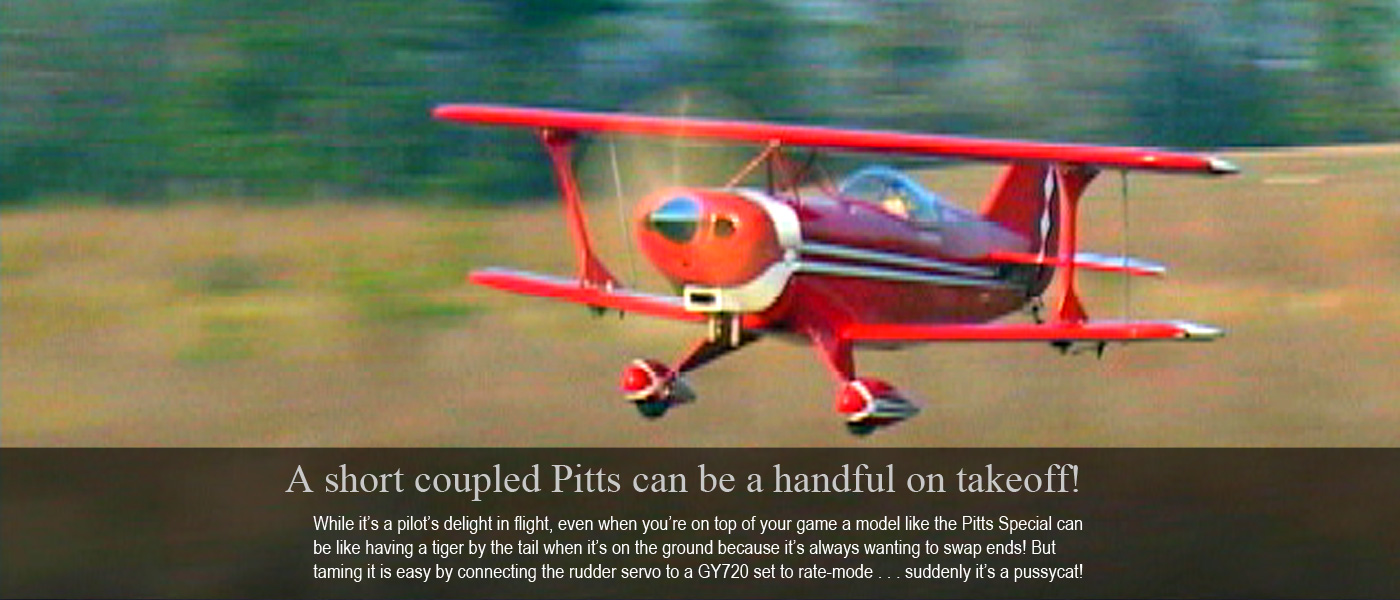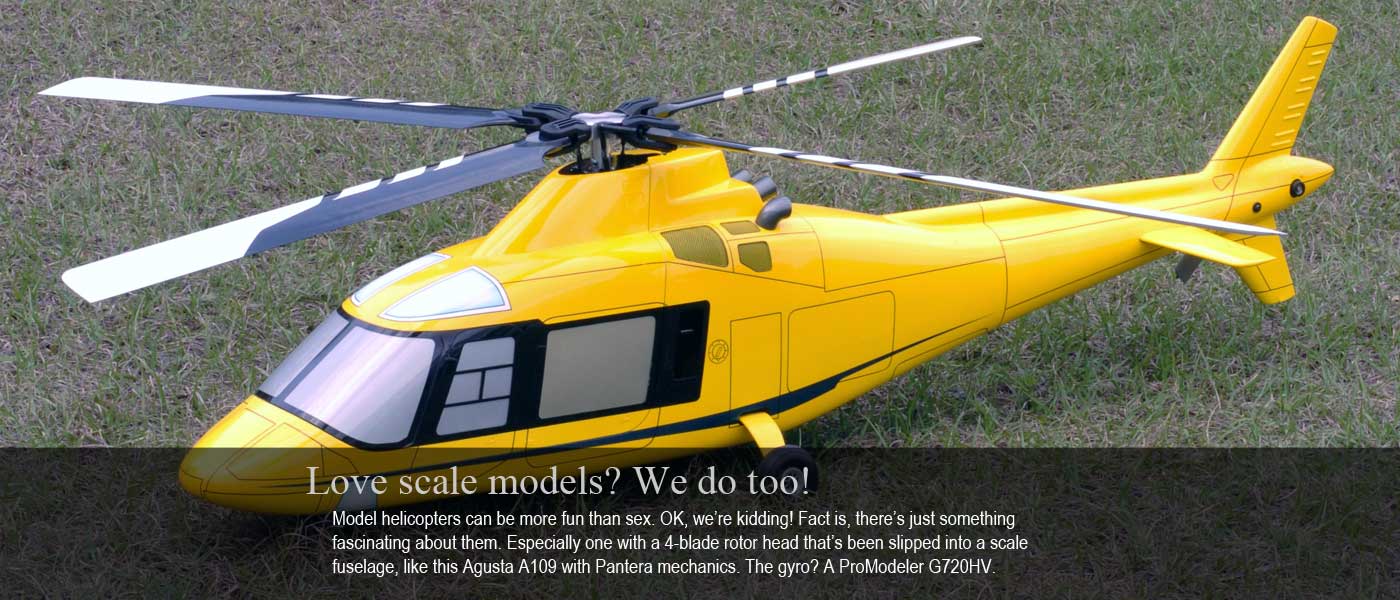Looking for a dedicated single-axis gyro to control the tail rotor of your
flybar-equipped model helicopter? You've just found a nice one that won't break the bank! Set it up for either rate-mode or heading hold-mode and fly with more confidence.
Think
gyros are just for helicopters? Think again, because gyros can be
pretty handy for fixed wing models too. For example, a Pitts Special can be a tough model for many because it's so short coupled it wants to swap ends (even when you're paying close attention).

But now, simply routing the rudder servo through the GY720 gyro and setting it to rate-mode means it instantly senses the loss of heading before you can even begin to see it. After all, because your head isn't inside the cockpit to sense and make micro corrections, you're relying on your eyes to sense the beginning of yaw. This can be nearly impossible with short coupled models!
However, by using a gyro to instantly correct with rudder - quicker than most can possibly recognize the situation - this little bit of technology lends you a hand. And no, it's not flying for you because it's just momentarily compensating for sudden rates of yaw, thus helping you be better pilot!

Pilots who love flying twin-engine models benefit especially because if you lose an engine the model can snap to inverted so fast you can't save it. Now, just by routing the rudder servo through the gyro set to rate mode means it'll maybe buy you the precious seconds needed to recognize what's going on and react. Think of this as cheap insurance for the inevitable engine out situation when asymmetrical thrust is going to immediately yaw the model. You know when Murphy will strike, too . . . when the model is too far away to easily determine which engine just crapped out. Go the wrong way with rudder and just like that, it's done. Toothpicks.

Another great candidate for a GY720 gyro on rudder is a high powered aircraft like a scale P-51 Mustang. With this tail dragger, opening the throttle to initiate the take off roll with a little too much aggression means P-factor (torque) drags the nose off to
the left - often before the model's rolling along with enough airspeed . . . unless you're on top of things and give it a lot of corrective right rudder immediately!

And because this even happens to highly experienced pilots - ones who know to add a bit of right
rudder before applying power - it can happen to anybody! Worse, while it usually results in
an aborted takeoff, how many times have you seen
someone plow-on, e.g. grab a handful of elevator and stagger into the air . . . usually while departing over the pits? That's bad, we all know it, and one thing that really help in this situation is avoiding it altogether. This gyro can help.
Installing this solid-state gyroscope is easy. Just attach it using double stick tape, Velcro, or our favorite, a dab of Show Goo (much tougher than silicone RTV and plug your rudder servo to it, then connect it to the receiver exactly where the rudder was. Then, if the model is fixed wing, set it to rate mode, heading hold if it's a helicopter, and go fly! You can even turn it on and off remotely with a spare channel.
Make no mistake; for
what amounts to a minor investment in the overall cost of your model,
you can greatly increase the margin of control and safety when you're at the field. So whether fitted to a helicopter, or a giant scale gasoline-powered Spitfire,
this is an important tool in your bag of tricks because it helps you be a
better pilot.


And don't let the low price fool you. Fact is, the design of the G720HV looks simple but is actually rather sophisticated. Basically, you can use it with pretty much any servo. For example, it doesn't matter whether it's attached to a
3-pole, coreless, or brushless motor servo. Analog or digital doesn't matter to the G720HV either. Even the the servo's neutral (1520µs or 760µs) is no issue.
Last thing, the G720HV has some pretty nice features. For example, it's got multi-mode, which means you can opt for either AVCS
(heading-hold mode) or rate-mode. You also can use it with NiCd, NiMH, LiFe, or LiPo battery chemistry (ranging between 4.8-8.4V). Plus a real nice touch is how instead of
a plastic case, it's housed in a case that's CNC-machined from a solid billet of 6061-T6
aircraft aluminum.
Bottom line? Whether you fly helicopters, are partial to short coupled WWI biplanes, or lust for the heavy iron of WWII warbirds, if you want a little peace of mind, put one of these in your model. You'll be glad you did the very first time you see it track arrow-straight and automatically correcting for a crosswind - believe it.
Want the latest in anti-drift MEMS sensor technology without breaking the
bank? The ProModeler G720HV delivers Heading Lock (AVCS) sensor technology in a
bullet-proof case . . . yeah, the case has been CNC-machined from a solid billet
of 6061-T6 aircraft aluminum. Think of it as the ultimate in rubber baby buggy bumpers!

- Ultra compact design makes the G720HV suitable
for helis from 250 to 800-class

Another thing, while it works with old fashioned 4.8V servos, the crew
at ProModeler designed this gyro expressly for unregulated 2S LiPo battery
packs. Moreover, while it works with old school 70Hz analog servos, to really get your money's worth, pair it up with a digital servo with a faster refresh rate, like 330Hz or 560Hz. Note, especially for helicopters, this gyro matches up nicely to either our standard-size ProModeler DS120BLHV or the mini-size DS085BLHV - both have brushless motors. You may also use it with a DS110CLHV (also for tail rotor control) but remember to set it to 1520µs. And of course, for fixed wing applications, any other servo in our lineup works perfectly!

- Survival of the fittest - CNC machined 6061-T6 aluminum
case for ultimate protection

Now you can learn to hover faster because heading lock mode keeps the tail of
your helicopter from swinging wildly due to wind gusts, or sudden changes in
throttle/collective. Later, when you take your model into forward flight, the
remote gain function smoothly transitions the gyro for permitting you to perform
blindingly quick flips as well as constant rate pirouettes.

- Dual modes, three types of servos . . . all from one
gyro, and it's HV as well

In short, being great for learning doesn't mean the G720HV is going to
hold you back when you're ready to learn 3D tricks because of the MEMS
technology ensures both agility and stability in one. And note, while the aluminum case offers great protection during crashes, the fact it's highly polished is simply for looks (for when your friends crowd around to cast an eyeball on your
model).

- Nicely packaged too as the protective jewel case
doubles as a product display

Measuring a bit less than one inch by one inch, and a mere half-inch thick, while weighing about 1/2 an ounce, this superb MEMS miniature gyroscope works with old
fashioned NiCd battery packs as well as the latest in 2S lithium-chemistry
receiver battery packs - without a voltage regulator - for the ultimate in high
performance! Best of all, whether your budget forces you to re-purpose an old
fashioned analog tail rotor servo (1520µs/70Hz), a standard servo (1520µs/330Hz), or for the extracting all the G720HV can offer by pairing
it up with the latest in high speed super servos (760µs/560Hz), this versatile high performance gyro makes it easier to hover and learn to
fly . . . without busting your budget.

- Dimensions and specifications of the G720HV Heading
Hold gyroscope

Frequently Ask Questions
Q. Why are there 2 male plugs ends and 1 female plug end on
the gyro? I know the female accepts the male plug lead from the tail servo, but
what's with having two male plugs ends for the receiver?
A. Yes, the male plug on the servo lead plugs into the
female plug end on the gyro. Next, the 3-wire male plug end from the gyro plugs
in where the servo would ordinarily go to control rudder (tail rotor) at the
receiver. The other male plug end (note, it only has 1-wire instead of 3 and
it's red in color) is for the remote gain. This is also plugged into the
receiver, but its purpose is to allow you to change gain between normal, and
idle up 1 and 2 (perhaps called stunt mode depending on what brand of radio you
fly) and usually plugs into channel 5. While the analogy ultimately breaks down,
for now think of gyro gain as volume on your TV, so here goes . . .
Just as the television may be louder (more gain) while watching a football
game with friends and quieter (less gain) when you're alone watching the news,
the purpose of the remote gain is to let you switch between say, 65% gain in
normal mode, to 40% in idle up 1 mode, down to perhaps 35% in idle up 2 mode.
This is because there is less need for gyro gain when the model is in forward
flight (using idle up 1) as compared to when you're hovering (using normal
mode), and there's even less need for gain (holding power) while performing
3D-type aerobatics (typically using idle up 2).
Anyway, you'll fiddle with these values (the % gain) based on what the model
does in flight . . . just as you raise or lower the volume on your television
using the remote control. In this case, to change the volume (or gain) in
flight, you raise or lower the % for each of the flight modes using your
transmitter's programming section. Please refer to your specific radio system
manual for details on how to do this with your particular radio system - but
note, all brands and all models within brands work this exact way but the
specifics of what they call the functions may vary, e.g. idle up 1 may be
referred to as stunt mode 1, etc.
How does it work in practice? Well, if the tail twitches back and forth
(characterized by a zoom-zoom-zoom sound, which is due to the tail blades
fanning air as the system hunt) you reduce the gain a little bit and go fly the
maneuver again. Repeat until it stops. If it's not hunting, raise the gain
%. While the hunting is easy to see up close, if it's happening too far away to
see in flight, then your ears are your partner for identifying what's going on
(hence listening for the zoom-zoom-zoom sound). Anyway, if the tail is
hunting, then simply reduce the gain until it stops however, just like you want
the television loud enough to hear clearly, the basic idea with gyro gain is to
run as much of it as you can (louder) until the tail begins to hunts left-right,
then lower it a little bit (quieter).
Q. What do you recommend for extending the gyro leads if
they won't reach the receiver?
A. We advise using the shortest possible servo extensions,
e.g. 4-6 inch (10-15cm) long for the P6. However, we urge you to be extremely
careful about cheapo extension because what you want are really good quality
gold-plated connectors. Unfortunately, cheapo extensions frequently are either
not gold-plated, or use really, really thin plating (gold is expensive so you
get what you pay for with low bidder extension, e.g. the gold plating is
thinner). Since you cannot tell the difference by looking, we suggest buying
from a reputable vendor. The point is; thin plating more readily wears off,
which leads to corrosion, and possible subsequent loss of control - you've
been warned! As an alternative to cheapo extensions from eBay or Amazon we
advise visiting the hobby shop and paying for high quality extensions (however,
because even hobby shops are prone to buying cheapo units to relabel with their
store brand, be careful and stick to name-brand extensions only).
Overall Customer Rating of 2 Reviews: